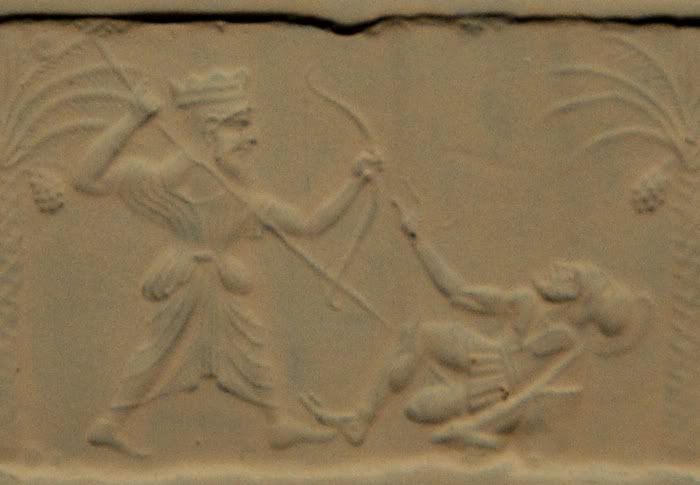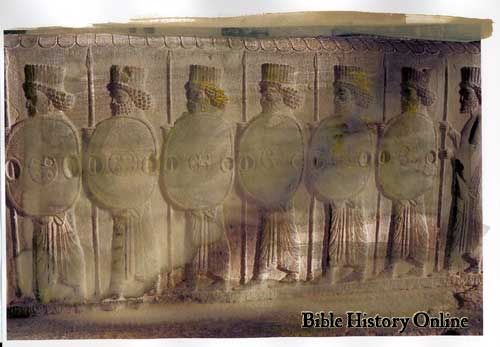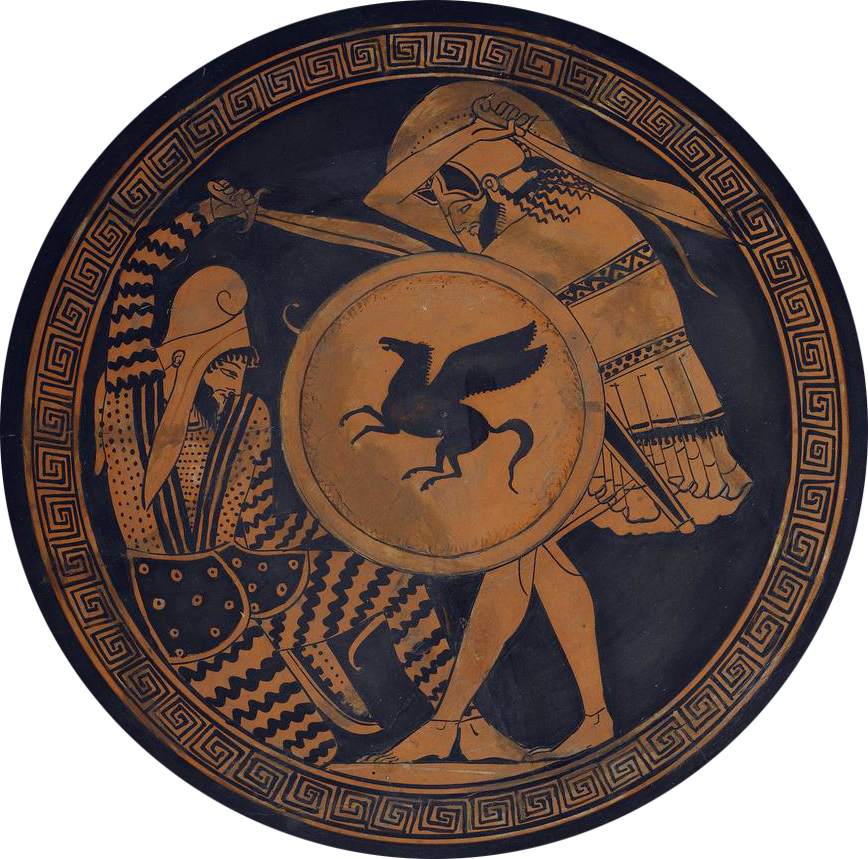-
January 13, 2010, 03:04 PM
#1
 A cautious but serious look at the Achaemenid Persian Infantry of Darius and Xerxes
A cautious but serious look at the Achaemenid Persian Infantry of Darius and Xerxes
First off let me say that this is much a chance for me to collect my thoughts and test out some ideas as it is a theory. So I fully welcome criticism and ideas to help develop my understanding.
Secondly the reason I am choosing the period which Darius and Xerxes ruled over is because I believe the Persian army was truly professionalised under Darius and after the disastrous defeats of Xerxes it underwent significant reform which is another topic for another day. If you disagree with the idea of reform then this analysis would simply cover more chronological territory.
I want to illustrate a sort of descending view of the military structure beginning with the king himself and radiating outwards from his bodyguards all the way to the Persians performing their national service. I will also be sticking entirely to the Persian ethnos as they are a tricky enough subject by themselves without expanding the analysis to every foreign levy. Fortunately the parts of my analysis covering the Persian regulars will apply, more or less, to many other Iranian contingents and thus cover the most important elements of the Persian army anyway.
I do not want to get into a discussion on the cavalry as their structure is much harder to define and of a lesser importance to the early Persian military which was an infantry based army. Neither do I want to get into a long discussion on how effective these troops were and end up with yet another Greeks vs Persians thread. This is about Persian structure and armament only.
For the purposes of this analysis:
Regiment = 10,000 men
Division = 1,000 men
Platoon = 100 men
Squad = 10 men
So without further ado -
The King
The Persian King was depicted and proclaimed as the ultimate paragon of manly virtue and martial prowess. Unlike the Assyrians, the Persian Kings took great pains to ensure that their boasts of soldierly achievement were always qualified with the notion that they were fighting evil doers. This is particularly obvious in the Behistun inscription of Darius the Great where what is clearly an ode to Persian military skill is constantly punctuated by the reiteration of the defeated people's evil intentions. It is however in the tomb inscriptions of Naquesh-e-Rustam and many of the coins and seals we have from these Kings that we see the message of the Kings military skill most highly praised. It was plainly a virtue which the Persians considered to be central to the idea of Kingship.

Seal of Xerxes depicting the King triumphing over a hoplite. This seal is argued to illustrate Xerxes' depiction of the war in Greece as a personal success.
The Royal Bodyguard - Apple bearers (Old Persian unknown or non-existent)
The royal bodyguard I refer to are the 1000 men detailed to protect the King in war and in the palace. They are often confused with what many now know as 'The Immortals' but this is in fact an entirely different division. Herodotus describes a unit of 1000 men that followed directly behind Xerxes on his march that were the 'Noblest of the Persians' and had golden apples for counterweights on their spears (Herodotus, 7. 41).
Also known as the Apple Bearers, this division of spearmen appears to have been recruited from the Persian nobility. This ties in very well with what we also know about the division of Spearbearers in that Darius himself served as a spearbearer for Cambyses II. Moreover, the Behistun inscription amongst others depicts Darius with a noble behind him carrying a spear and given the caption of 'spearbearer'. This could either mean he is carrying the King's spear or more plausibly that he is the captain of the king's bodyguard and was known as the 'hazarapatis' (commander of one thousand). The Hazarapatis acted as something of a first minister as well as a chief of security. It was through him that all audiences with the King were granted or petition's heard (Nepos, Conon, 3. 2-3. Plutarch, Life of Themistocles, 27. 2-7. Aelian, VH 1.21).
The fact that they are depicted as wearing the same head dress as the Great King on the Persepolis reliefs lends credence to the idea that they were of noble stock. Moreover it is a particularly sensible idea to tie the loyalty of the youth of the nobility to the King so directly. Unless, if you believe it of course, you happen to recruit an overly Machiavellian, ruthless genius by the name of Darius into your personal guard.
It is difficult to tell how the apple bearers would have been attired on campaign but in the palace they are dressed to mirror the King himself, certainly a high honour. Sekunda goes so far as to suggest that they were even permitted to wear robes of similar colour and patterning (Sekunda, Persian Army, 11-12). But the most interesting thing about the Apple Bearers is the size of their spears. The reliefs at persepolis have regularly fluctuating spear lengths due to the restrictions of the stone space available to the artist. But the Apple Bearers depicted in the audience scenes have spears far longer than any of their soldierly counterparts. They are also depicted without any bows or projectile weapons. This is clear enough evidence that the Persians had at least small divisions of infantry entirely dedicated to melee combat.

Audience relief at Persepolis depicting the King recieving the hazarapatis. The Apple Bearers are stationed to either side of the relief. Note the long spears and headgear. Also of note are the heir apparent standing behind the throne, the Royal chamberlain behind him and finally the weapon bearer of the King carrying his axe and more importantly his bow, the royal insignia.
The Elite Spearmen - Arstibara
It is often surmised that the so called Immortals were the picked elite of the Persian army but this is an erroneous theory. They might have constituted the backbone of the army as its standing, professionalised core of dependable soldiers and could be considered elite when compared to a regular regiment but it appears that the Persians maintained a picked division that ranked even higher.
Herodotus also mentions a body of Persians that marched before Xerxes that numbered 1000 men. In this case, however, he does not say that they were picked for their rank but merely that they were chosen men(Herodotus 8. 40). This is not the first time divisions of elite spearmen are to be found in the Persian empire. Oroetus was said to keep a bodyguard of 1000 Persian spearmen, perhaps in imitation of the King, before he was executed for rebellion. Interestingly enough it was these very bodyguards that, once they had been told that Darius had ordered the death of Oroetus, performed the excecution (Herodotus 3. 127-128). It is tempting to suggest that the decision of these spearmen to side with Darius and demonstrate such loyalty was the precursor to their redesignation as the elite division Herodotus later refers to. Either way, divisions of devoted, commoner spearmen appear to be attested.
Going back to the Persepolis reliefs there is a particularly interesting frieze which depicts a comparitively smaller body of troops marching together armed solely with spears and the dipylon shield. It is not possible to tell how long the spears might have been since there was not space on the stone to carve the sorts of long spears that the apple bearer's carried. But it is logical to assume that a unit devoted to melee fighting would choose the long spear over the short if both were ready to hand. We can also assume that a unit of such prestige and melee focus would wear the customary Persian scale armour but there is absolutely no evidence for Persian infantry wearing helmets. They would have worn the campaign head dress that tied around the chin known as the 'kidaris' or 'tiara'. The relative silence on the matter of Persian heavy infantry with long spears can be readily explained by the rather small size of the unit itself. However, it is possible that this division was the very same '1000 best men of Persia' that fought to the death with Mardonius at Platea (Herodotus, 9. 63). It is more reasonable to explain that the drawn out length of the fight which Herodotus describes and the success he attributes to these Persians was due to the fact that they had a dedicated unit of melee infantry ready to fight. This is much more preferable to the idea that Mardonius was supposedly inflicted casualties and faring well in a stand up fight against a phalanx with a body of 1000 horsemen. Still, they weren't hoplites nor am I suggesting that they fought in what could be described as a phalanx.

Persian infantry marching in close formation with spears and solid wooden, bronze bossed shields with bronze rims. The Crenellated head dress is similar to all common Persian soldiers depicted in parade dress at Persepolis.
Now it is possible that the soldiers depicted here are in fact the Apple Bearers marching to war. However there are a few problems with this idea. Firstly they are wearing a parade head dress but not their own noble one. Persians are never depicted as wearing the crenellated crown in battle except for the King who is heroically illustrated with just his royal robe and as such does not constitute an accurate depiction. Moreover they are still wearing their parade robes rather than trousers or armour. Lastly this goes against the distinction Herodotus makes between the noble division and the picked division.
Now the next idea is purely conjecture but it doesn't much affect the rest of the analysis. It is possible that Mardonius did not pick the immortals to stay behind with him in Greece and that he instead chose this division of spearmen. It is a tactically superior choice since the Immortals were armed and fought in much the same way as any Persian infantry regiment that he could request but what Mardonius needed were dedicated spearmen. Moreover the strange departure of Hydarnes, the immortals commanding officer, suggests that perhaps they did all go with Xerxes to maintain order in Asia minor/suppress the Babylonians. It is obvious that the more important theatre of war for the Persians would have been on the home front. But either way this does not add much to the analysis it is simply a suggestion.
The Professional Army, A.K.A the Immortals - Anusyia
From here onwards I will be referring to the Immortals as the Anusyia and I urge everyone else to do the same because its a far more accurate term.
The Anusyia are the most famous Persian regiment, probably almost entirely by the virtue of their name. Always kept up to full strength and always under arms they constituted the heart of the Persian army; they were armed with bow, shield, spear and sword they were capable of tackling most situations offered to them(Herodotus 7. 61 and 83).
It is perhaps neccesary to point out that every Persian infantry regiment would, at its creation, field 10,000 men and consist of troops armed with bows, spears, shields and swords. It is perhaps a grave mistake to assume that within the regiment of the Immortals, every trooper carried every weapon. But Herodotus tells us the Persian regiment of 10,000 that accompanied the King with the elite units all carried spears. It is seemingly implausible that someone carrying all that equipment would even be able to discharge a bow but if the accepted equipment is reconfigured it may make more sense.
It is usually accepted that the Anusyia carried the Dipylon shield since it is often taken as a given that it was a superior shield to the Spara. However, for the style of fighting which the Anusyia practiced the Spara would make considerably more sense. The Anusyia were intended to be able to win archery duels before they engaged and the Spara is integral to the defense of the line troopers from missile attacks. Moreover we know from the reports at Mycale that the Spara shield, when propped up, could stand without the support of a soldier. This, if we assume the soldier has planted his spear in the ground, would allow the Anusyia to carry all their weaponry as they are described and still function as they are described.
Therefore it can be surmised that the only troops who carried the Dipylon shield were the Arstibara who would have needed it for their role and possibly the Apple Bearers due to the unweildy nature of the Spara and the melee designation of the bodyguards. However, in contrast to the average Persian regiment the Anusyia were considerably better paid according to Herodotus and it is likely that every man in the regiment could afford a corslet of iron scale armour making the unit a very large and versatile formation.
As a final note it is often surmised from Herodotus that the troopers with golden counterweights surrounding the silver ones on Xerxes' march comprised an elite division (Sekunda, Persian army, 6-7) but these 1000, Golden troopers were in all likelihood the Squad leaders for the 1000 platoons (Old Persian: Datapatis).
It is perhaps worth mentioning where and when the Anusyia were most likely formed. This is of course just a theory with little evidence but it is at least logical. The most telling thing about the Anusyia is that their name means 'followers' or 'supporters.' When set in the context of the chaotic times in which Cambyses died and the empire was in the throes of usurpation. To set the scene, the throne had been taken by Cambyses' brother but a Royal army was still operating in Egypt. Darius had possibly served as Cambyses' Hazarapatis in Egypt and on his death it is seemingly the case that the Persian troops supported his promotion to head of the loyalist army. In the wake of Darius' elevation to the throne, whilst every province was eager to rebel and aggrandise itself, the army which followed Darius stayed true and helped him restore the empire. Their reward appears to have been higher pay and constant re-supply. Their impressive battle record and obvious experience seems to have led to the creation of the standing military tradition.

The Anusyia's parade dress appears to be a direct copy of the Elamites dress or perhaps an homage to their urban mentors. The glazed brick troopers often shown to be what a Persian soldier looks like are either a genuine depiction of Elamites or the Anusyia on parade.
Regular Infantry - Pasti
The regular infantry were armed fairly similarly to the Anusyia but it seems unlikely that they were trusted to operate on every tactical level. The usual depictions of Persians in attic pottery have them either as spearmen or archers giving rise to the opinion that the regular infantry operated in the traditional 'thick crust,' shielded archer formation.
The major difference however is how these regiments were recruited, used and disbanded. There is agreement between Xenophon, Herodotus and Strabo that Persian youths were instructed in military training at a young age up until they were fit for service when they were conscripted into regular regiments and after their service was done they were rewarded with land grants by the King under the Hatru system. Once given their land they remain liable for military service in the case of a major campaign or emergency but they were only required to send a man for every piece of land so they were not directly obligated to go themselves.
Where Herodotus, Strabo and Xenophon disagree is on the age of the Persians before they were first trained, how long they spent in the military as a soldier and how long they were liable to be called up again. It is also important to note that this system was most likely instituted under Darius since Cyrus and Cambyses probably did not have the regulation and organisation to practice such a system. Their population of Persis was also unlikely to have been fully enjoying the lack of taxes and abundance of free labour that they did under Darius.
The Persian empire was almost always at war with someone or another but there were enough garrisons throughout the empire to fill with Persian regiments on service rotation. One imagines the average Persian youth considered garrison duty to be the cushiest job available.

Persian archer exposed to a hoplite's wrath after losing his spearman bodyguard.
As I said before, the above is a collection of ideas rather than a statement of proposed facts. Any questions will only help improve my research. By the same token, simply saying that you might have learned something or agree with my conclusions would be just as helpful.
Last edited by rez; January 21, 2010 at 02:58 PM.
 Posting Permissions
Posting Permissions
- You may not post new threads
- You may not post replies
- You may not post attachments
- You may not edit your posts
-
Forum Rules





















 Reply With Quote
Reply With Quote




